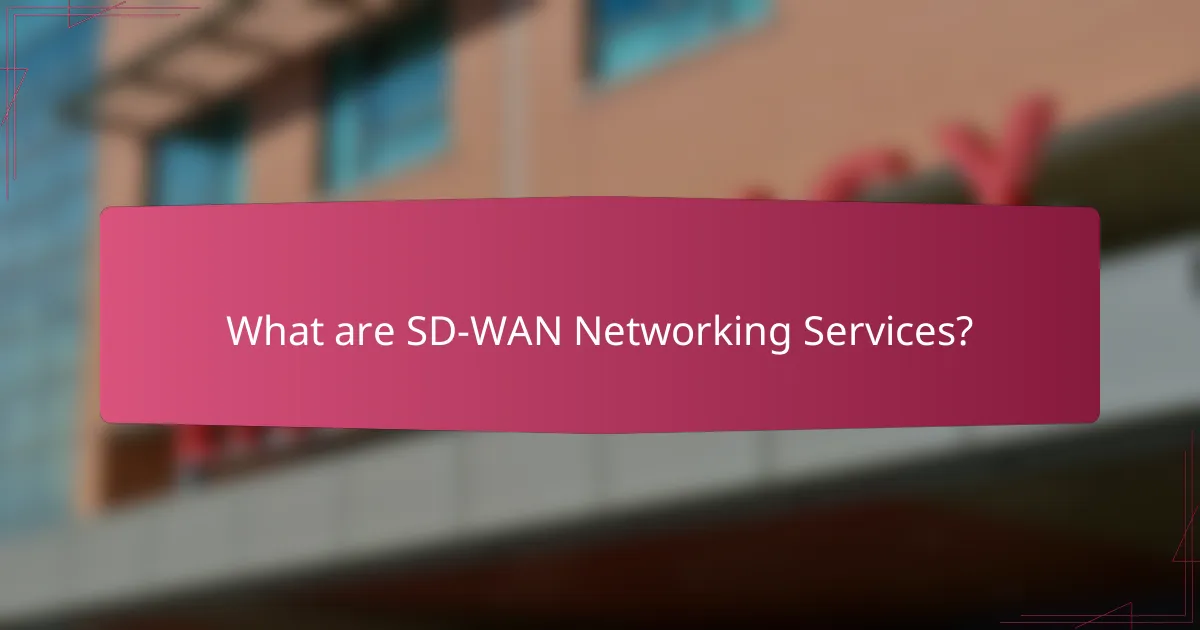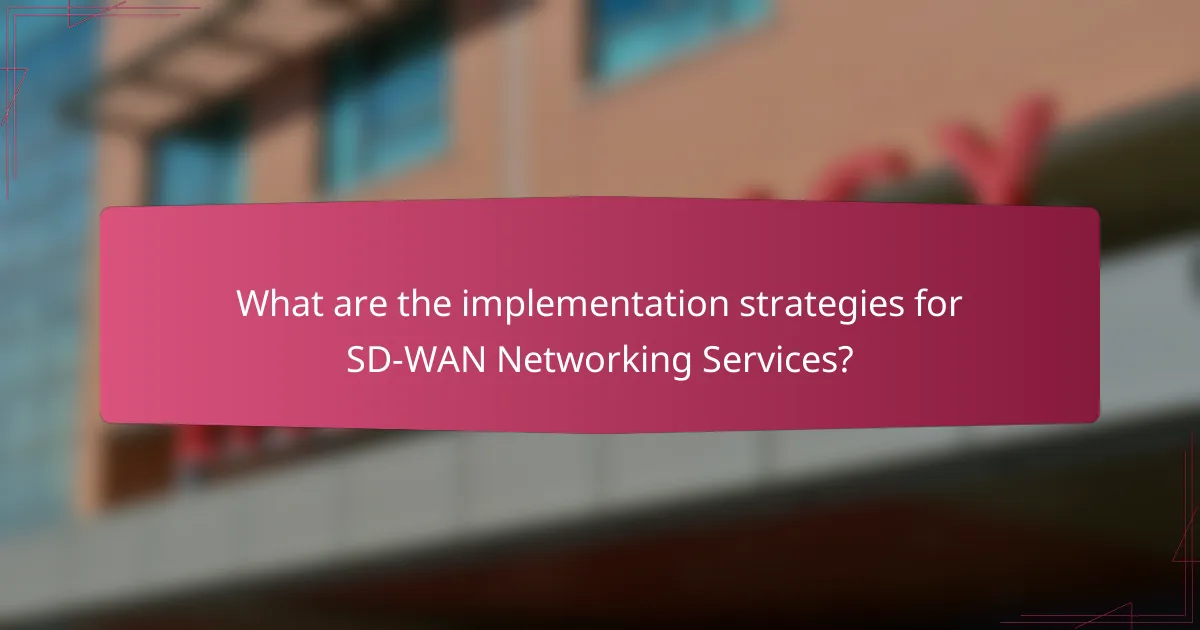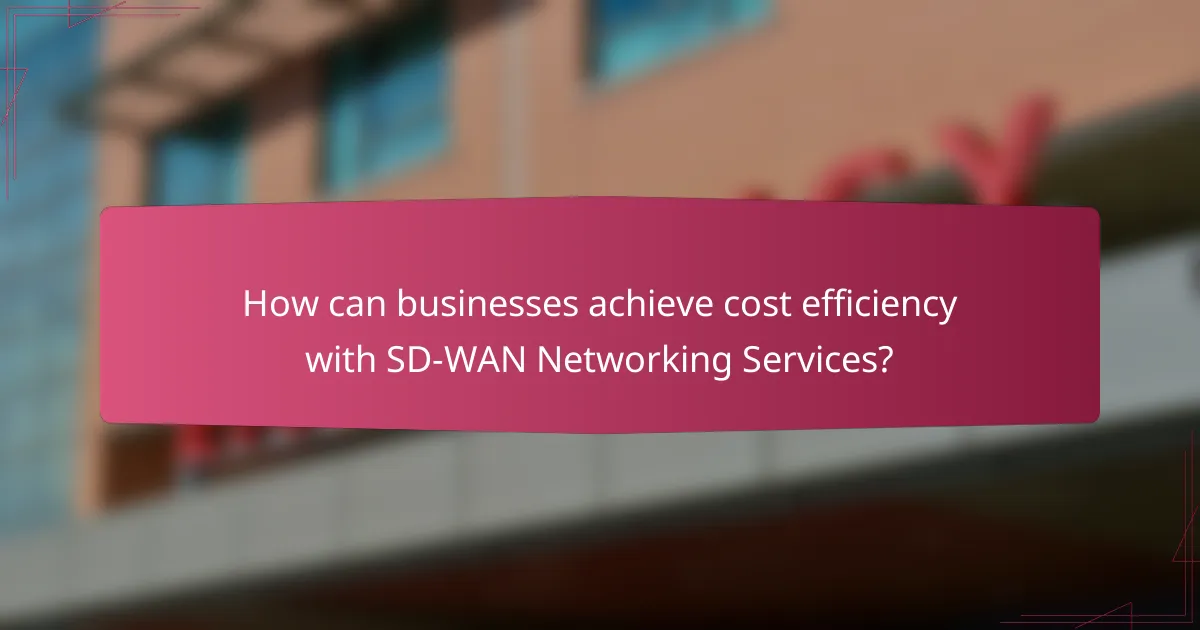
What are SD-WAN Networking Services?
SD-WAN Networking Services are software-defined wide area network solutions. They enable organizations to connect multiple locations over the internet securely and efficiently. SD-WAN optimizes network traffic by directing it based on real-time conditions. This service enhances application performance and reduces costs compared to traditional WAN solutions. According to a 2021 report by Gartner, SD-WAN adoption can lead to a 30% reduction in networking costs. Moreover, SD-WAN provides centralized management for easier network control and visibility. It supports various connection types, including MPLS, LTE, and broadband. This flexibility allows businesses to choose the best connectivity options for their needs.
How do SD-WAN Networking Services differ from traditional WAN?
SD-WAN Networking Services differ from traditional WAN in their ability to leverage multiple connection types for improved performance and flexibility. Traditional WAN relies heavily on dedicated MPLS circuits, which can be costly and less adaptable. SD-WAN uses broadband, LTE, and other connections, allowing for dynamic path selection based on real-time conditions. This results in better bandwidth utilization and reduced latency.
Additionally, SD-WAN offers centralized management through a cloud-based controller, simplifying network configuration and monitoring. Traditional WAN often requires manual configurations at each site, which can be time-consuming and prone to errors. SD-WAN’s automated processes enhance operational efficiency and reduce the risk of misconfigurations.
Moreover, SD-WAN enhances security by integrating features such as encryption and secure gateways, which are often not standard in traditional WAN setups. This multi-layered security approach helps protect data across various connection types. Overall, SD-WAN provides a more agile, cost-effective, and secure networking solution compared to traditional WAN.
What are the key components of SD-WAN technology?
The key components of SD-WAN technology include centralized control, secure gateways, and application-aware routing. Centralized control enables network management from a single interface, simplifying operations. Secure gateways provide encrypted connections to the internet and cloud services. Application-aware routing optimizes traffic based on application requirements, ensuring performance and reliability. These components work together to enhance network efficiency and security. SD-WAN technology is designed to improve connectivity and reduce costs for organizations.
How does SD-WAN enhance network performance?
SD-WAN enhances network performance by optimizing traffic routing and improving bandwidth utilization. It dynamically directs data across the most efficient paths based on real-time conditions. This reduces latency and increases application performance. SD-WAN also enables prioritization of critical applications. By ensuring that high-priority traffic receives the necessary bandwidth, it enhances user experience. Additionally, SD-WAN offers centralized management and visibility. This allows for quicker adjustments to network configurations, improving overall responsiveness. According to a report by IDC, organizations implementing SD-WAN can see a 50% reduction in network-related issues, further validating its performance benefits.
What are the primary benefits of SD-WAN Networking Services?
The primary benefits of SD-WAN Networking Services include improved network performance, cost savings, and enhanced security. SD-WAN optimizes traffic routing based on real-time conditions. This leads to better application performance and user experience. Cost savings are achieved by utilizing lower-cost internet connections alongside traditional MPLS. Enhanced security features, such as encryption and secure gateways, protect data across the network. Additionally, SD-WAN simplifies network management through centralized control. This allows for quicker deployment of new applications and services. Overall, these benefits contribute to increased operational efficiency for organizations.
How does SD-WAN improve network security?
SD-WAN improves network security by enabling end-to-end encryption of data traffic. This ensures that sensitive information is protected from interception during transmission. Additionally, SD-WAN provides centralized security policies that can be consistently applied across all network endpoints. This reduces the risk of misconfigurations that can lead to vulnerabilities. Furthermore, SD-WAN integrates with various security services, such as firewalls and intrusion detection systems. This enhances overall threat detection and response capabilities. According to a report by IDC, organizations using SD-WAN experience a 50% reduction in security incidents. This statistic underscores the effectiveness of SD-WAN in strengthening network security.
What cost savings can businesses expect from implementing SD-WAN?
Businesses can expect significant cost savings from implementing SD-WAN. SD-WAN reduces operational costs by optimizing bandwidth usage. It enables the use of lower-cost internet connections, such as broadband and LTE, instead of expensive MPLS circuits. According to a report by IDC, companies can save up to 60% on network costs with SD-WAN. Additionally, SD-WAN simplifies network management, reducing the need for extensive IT resources. This efficiency can lead to decreased staffing costs and faster deployment times. Overall, the transition to SD-WAN can result in substantial financial benefits for businesses.

What are the implementation strategies for SD-WAN Networking Services?
Implementation strategies for SD-WAN Networking Services include assessing network requirements, selecting appropriate SD-WAN solutions, and deploying a phased rollout. Assessing network requirements involves analyzing current infrastructure and identifying performance needs. Selecting appropriate SD-WAN solutions requires evaluating vendors based on features, scalability, and support. A phased rollout allows organizations to minimize disruptions. It typically starts with non-critical sites before expanding to core locations. Monitoring and optimizing performance is crucial throughout the deployment. Regular assessments ensure the SD-WAN meets evolving business needs. These strategies enhance network agility and reduce costs, as supported by industry reports indicating up to 30% savings on network expenses with SD-WAN adoption.
How should businesses assess their readiness for SD-WAN?
Businesses should assess their readiness for SD-WAN by evaluating their current network infrastructure and requirements. They need to identify existing bandwidth usage and application performance. Understanding the organization’s specific needs is crucial for effective SD-WAN deployment. Businesses should also consider their ability to manage and support a hybrid network environment. Assessing security requirements is essential, as SD-WAN changes how traffic is routed and secured. Additionally, evaluating the skills of the IT team is important for managing the new technology effectively. Finally, businesses should review their budget to ensure they can support the transition to SD-WAN.
What factors should be considered during the SD-WAN selection process?
Key factors to consider during the SD-WAN selection process include network performance, security features, and scalability. Network performance is crucial for ensuring optimal application delivery and user experience. Security features must encompass encryption and threat detection to protect sensitive data. Scalability allows organizations to adapt to changing business needs without significant disruptions. Additionally, consider vendor reputation and support services for reliable implementation and ongoing maintenance. Finally, assess cost structure, including initial investments and ongoing operational expenses, to ensure budget alignment.
How can organizations effectively plan their SD-WAN deployment?
Organizations can effectively plan their SD-WAN deployment by following a structured approach. First, they should assess their current network infrastructure and identify specific business needs. This involves understanding application performance requirements and user experience expectations. Next, organizations must choose the right SD-WAN solution that aligns with their goals. This includes evaluating different vendors and their offerings based on features and scalability.
After selecting a solution, organizations should develop a detailed implementation plan. This plan should outline timelines, resource allocation, and key milestones. Additionally, organizations must ensure proper training for IT staff and end-users to facilitate a smooth transition.
Finally, monitoring and optimization are crucial post-deployment. Organizations should regularly review performance metrics and user feedback to make necessary adjustments. According to a report by Gartner, effective SD-WAN deployments can lead to up to 90% reduction in network costs and improved application performance.
What are common challenges faced during SD-WAN implementation?
Common challenges faced during SD-WAN implementation include network complexity, integration issues, and performance concerns. Network complexity arises from the need to manage multiple connections and devices. Integration issues can occur when aligning SD-WAN with existing infrastructure. Performance concerns may stem from inadequate bandwidth or latency problems. Additionally, security challenges can arise as organizations transition to cloud-based services. According to a report by Gartner, 60% of organizations experience integration difficulties during SD-WAN deployment. This highlights the importance of thorough planning and assessment before implementation.
How can organizations mitigate risks associated with SD-WAN deployment?
Organizations can mitigate risks associated with SD-WAN deployment by implementing robust security measures and conducting thorough assessments. Security measures include encryption, firewalls, and intrusion detection systems. Conducting risk assessments helps identify vulnerabilities within the network. Regular monitoring of network performance ensures issues are addressed promptly. Training staff on SD-WAN technologies reduces human error. Collaborating with experienced vendors provides insights into best practices. Establishing clear policies for data management protects sensitive information. These strategies collectively enhance the security and reliability of SD-WAN deployments.
What are the best practices for ensuring a smooth transition to SD-WAN?
The best practices for ensuring a smooth transition to SD-WAN include thorough planning, stakeholder engagement, and phased implementation. Organizations should assess their current network infrastructure before transitioning. This assessment helps identify gaps and areas for improvement. Involving key stakeholders ensures alignment with business goals and user needs. A phased implementation allows for testing and adjustments. This reduces risks associated with a full-scale rollout. Regular monitoring and performance evaluation are essential throughout the transition. According to Gartner, proper management during the transition can lead to a 30% reduction in operational costs.

How can businesses achieve cost efficiency with SD-WAN Networking Services?
Businesses can achieve cost efficiency with SD-WAN Networking Services by optimizing bandwidth usage and reducing reliance on expensive MPLS circuits. SD-WAN allows for the aggregation of multiple types of connections, including broadband, LTE, and MPLS. This flexibility enables businesses to choose lower-cost internet options while maintaining performance.
Additionally, SD-WAN solutions often include centralized management and automation features. These features reduce the need for extensive IT resources and manual configurations. According to a study by Gartner, organizations can save up to 30% on networking costs by transitioning to SD-WAN.
Furthermore, SD-WAN enhances application performance through intelligent path control. This ensures that critical applications receive the necessary bandwidth without incurring additional costs. Overall, the combination of reduced hardware expenses, lower operational costs, and improved performance contributes to significant cost efficiency for businesses using SD-WAN services.
What are the direct cost benefits of using SD-WAN?
SD-WAN reduces operational costs significantly. It lowers the need for expensive MPLS circuits. Businesses can utilize lower-cost internet connections like broadband or LTE. This flexibility leads to substantial savings on bandwidth expenses. SD-WAN also simplifies network management. It reduces the need for on-site IT resources. According to a report by Gartner, companies can save up to 30% on network costs. Additionally, SD-WAN offers enhanced scalability without incurring high costs. This adaptability allows businesses to grow without significant financial strain.
How does SD-WAN reduce operational expenses?
SD-WAN reduces operational expenses by optimizing network resource usage and minimizing hardware costs. It enables the use of lower-cost internet connections, such as broadband, instead of expensive MPLS links. This flexibility allows businesses to scale their networks efficiently without significant investment in infrastructure. SD-WAN also centralizes network management, reducing the need for on-site IT support. According to a report by IDC, companies can save up to 40% on networking costs by adopting SD-WAN solutions. Additionally, the technology improves application performance, leading to increased productivity and reduced downtime, further contributing to cost savings.
What long-term financial advantages does SD-WAN provide?
SD-WAN provides significant long-term financial advantages through reduced operational costs and enhanced network efficiency. It lowers the cost of bandwidth by enabling the use of lower-cost internet connections alongside traditional MPLS. Companies can save up to 60% on their connectivity expenses by leveraging SD-WAN. Additionally, SD-WAN simplifies network management, which reduces the need for extensive IT resources. This efficiency can lead to a decrease in operational overhead. Furthermore, SD-WAN enhances application performance, which can improve productivity and reduce downtime costs. Organizations can also benefit from faster deployment of new sites, resulting in quicker time-to-market for services. Overall, SD-WAN contributes to long-term financial savings and improved return on investment.
How can organizations measure the ROI of SD-WAN implementation?
Organizations can measure the ROI of SD-WAN implementation by evaluating cost savings, performance improvements, and enhanced agility. Cost savings can be analyzed through reductions in bandwidth expenses and lower operational costs. Performance improvements can be assessed by monitoring application performance and user experience metrics. Enhanced agility can be measured by the speed of deploying new services and scaling network resources. A study by Gartner indicates that organizations can achieve up to 30% reduction in WAN costs with SD-WAN. Additionally, a survey by IDC found that 70% of businesses reported improved application performance post-SD-WAN implementation. These metrics provide a clear framework for assessing ROI effectively.
What metrics should be tracked to evaluate SD-WAN performance?
Key metrics to track SD-WAN performance include latency, jitter, packet loss, and bandwidth utilization. Latency measures the delay in data transmission. Jitter quantifies the variation in packet arrival times. Packet loss indicates the percentage of lost data packets during transmission. Bandwidth utilization assesses the efficiency of data transmission relative to the available bandwidth. Monitoring these metrics helps identify performance issues and optimize network efficiency. According to a report by Gartner, organizations that regularly track these metrics can improve their network performance by up to 30%.
How can businesses conduct a cost-benefit analysis for SD-WAN?
Businesses can conduct a cost-benefit analysis for SD-WAN by comparing the costs of traditional WAN solutions with the benefits of implementing SD-WAN. First, identify all costs associated with both options, including hardware, software, and operational expenses. Next, quantify the benefits of SD-WAN, such as improved bandwidth efficiency, reduced latency, and enhanced security features.
Use metrics like total cost of ownership (TCO) and return on investment (ROI) to evaluate financial impacts. For instance, a study by IDC found that organizations can achieve a 50% reduction in operational costs with SD-WAN compared to traditional methods. Additionally, consider qualitative benefits, such as increased agility and scalability, which can enhance overall business performance.
What are the key takeaways for successfully leveraging SD-WAN Networking Services?
Key takeaways for successfully leveraging SD-WAN Networking Services include understanding its architecture, which integrates multiple connection types. Businesses should prioritize centralized management for better visibility and control. Implementing application-aware routing enhances performance by directing traffic based on real-time conditions. Security features, such as built-in encryption and firewalls, are essential for protecting data. Regular monitoring and analytics help optimize network performance and identify issues proactively. Choosing a reputable vendor ensures reliable support and updates. Finally, aligning SD-WAN with business goals maximizes its benefits, improving overall operational efficiency.
SD-WAN Networking Services are software-defined solutions that enable secure and efficient connectivity across multiple locations. This article covers the benefits of SD-WAN, including improved network performance, cost savings, and enhanced security features. It outlines implementation strategies, key components, and how organizations can assess their readiness for SD-WAN adoption. Additionally, the article discusses metrics for evaluating performance and measuring ROI, as well as best practices for a successful transition to SD-WAN. Overall, it provides a comprehensive overview of how SD-WAN can optimize network operations and reduce costs for businesses.




